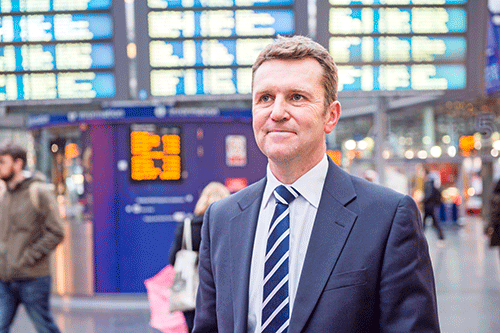 Read Alex Hynes' interview with Paul Clifton.
Read Alex Hynes' interview with Paul Clifton.
Read the peer reviews for this feature.
Download graphs for this feature.
An unemployed woman is late for an interview, and her benefits are slashed in consequence. A teenager is forced to turn down the offer of a college place because he can’t afford the rail fare. A pensioner struggles to make a late hospital appointment because the last bus home leaves at 1700. A developer has a planning application for social housing turned down because the public transport provision isn’t good enough.
These are the people who need to benefit from the devolution of transport powers. If Transport for the North cannot make their lives better, it will have failed.
There is grand talk of a road tunnel, or a rail tunnel, or even one that combines both, running under the Pennines between Manchester and Sheffield.
It may help the fit and healthy business travellers who can (frankly) afford the time wasted in traffic jams, or who can stand on crowded trains. But devolution is about reaching the people central government cannot reach, unleashing local solutions appropriate for local people.
Top-down, Westminster-led infrastructure is out. Regional-based people power is in. This is all about creating a healthier, more productive society in places that do not yet feel the warmth of London’s booming economy.
But hang on to that soft focus, sun-drenched image of public transport perfection. Because it’s a long way off yet.
Transport for the North is currently a team of 15 people, with a few more helping out in council offices around the region. They work for David Brown (chief executive) and John Cridland (very part-time chairman). They have vision and enthusiasm. But these are early days.
“We have a number of workstreams,” explains Brown at his borrowed office in the home of Transport for Greater Manchester. It sounds like his task is about as difficult as herding cats, each one determined on picking a different course.
“One is working with Network Rail, High Speed 2 and the Department for Transport on developing Northern Powerhouse Rail. That’s the potential new line from Liverpool to Hull and Newcastle, as well as influencing Control Period 5, the fallout from the Hendy Review, and any future schemes in CP6.
“The second is working with Highways England. They have three strategic studies looking at potential change to the trunk road network and a potential new tunnel between Greater Manchester and South Yorkshire.
“There are three other workstreams. One is pulling together a northern approach to freight. Another is local connectivity - schemes at a sub-regional level. And international connectivity - the places in the world to which we need better connections, and from which airports.”
Compared with the giant Transport for London, Brown’s budget barely registers on the graph. He has £10 million a year for the rest of this Parliament. Plus up to £150m to roll out smart ticketing and information, predominantly on rail. And potentially up to £120m in a Transport Development Fund for the tunnel plan.
The tunnel is the headline-grabbing grand gesture. The 40-mile road journey can take two hours on a bad day… the fastest train takes 48 minutes. There’s even a feasibility study into digging a trans-Pennine tunnel with road and rail side by side. But given that the national government already has HS2 as its flagship legacy to the north, how serious is this really?
“It is the first time this has been looked at comprehensively. There is no obvious way of moving between Manchester and South Yorkshire by road, without taking a very long time on roads that were never designed for the volume of traffic.
“They’ve identified five corridors. In the autumn there will be a preferred route, quantifiable costs and benefits. This is not being done lightly - this is a well-resourced piece of work.”
The Bill that established Transport for the North has been given Royal Assent. The organisation now officially exists. Next on the agenda: convince central Government what the organisation should look like, the role it should fulfil, and the powers it needs to achieve its objectives. In short: how much of its role the Department for Transport should surrender.
Brown has to be a master juggler - a diplomat as skilled as a Chinese ambassador to North Korea. Remember the showman spinning a hundred plates on tiny poles you watched on Blue Peter when you were a kid?
Somehow he has to pull along 49 competing local authorities of different political persuasions and with different concepts of localism, each with its own specific geographical issues. He has to present their united single vision to civil servants in London who must wave goodbye to their own power and influence, and he must persuade more civil servants at the Treasury to fund it. At the same time, he has to carry with him the private sector companies that operate the trains, the engineering giants that will build new rolling stock, and a Network Rail that is struggling to meet its own recently modified modernisation targets.











